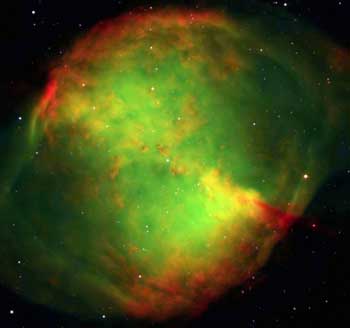Delphinus, Sagitta and Vulpecula
Delphinus (the Dolphin) and Sagitta (the Arrow) possess between them no star brighter than the third magnitude but the asterisms formed by their main stars are easily recognisable close to the richest part of the northern Milky Way in Cygnus and both are amongst the original 48 constellations of Ptolemy’s “Almagest”.

Vulpecula (the Fox) is a more modern invention of Hevelius in 1690 and is fainter still with only one star of even the fourth magnitude. The insignificance of Vulpecula’s stars is more than compensated for by the fact that it contains within its borders, the planetary nebula Messier 27. This object has a fair claim to being the finest of its type in the sky. It is a firm favourite for astro-photographers and is commonly known as the “Dumb-bell Nebula”, due its unmistakable twin-lobed appearance. Vulpecula possesses another remarkable sight for deep sky observers. This is the asterism Collinder 399 sometimes called Brocchi’s Cluster, but far more commonly known as “The Coat Hanger” due to its uncanny resemblance to that household object, something best appreciated in binoculars.

M27, the Dumb-bell nebula. (VLT image)
Sagitta possesses one object from the Messier catalogue which is M71. This is a curious cluster, apparently intermediate in type between the galactic and globular varieties. Delphinus possesses the very interesting globular cluster NGC 7006, which at a distance of 185,000 light years is probably the furthest such object from us apart from the famous “intergalactic wanderer”, NGC 2419 in Lynx. Like that object, NGC 7006 (in the eastern part of Delphinus and not shown on the above chart) may well not be gravitationally bound to the Milky Way at all, but despite its great distance it is, at 11th magnitude well within the range of modest telescopes.
The brightest two stars of Delphinus are called Sualocin and Rotanev, which when reversed spell the latin version of the name of the assistant of Giuseppe Piazzi, who discovered the first asteroid (Ceres) in 1801. Rotanev, the brighter of the two is double. Although the two components are fairly well matched (with magnitudes of about 4.0 and 4.9) and are currently at the widest separation of their 27 year orbit, the split is still less than one arc second and therefore a severe test for most amateur instruments. A much easier double is Gamma Delphini whose 4.5 and 5.5 magnitude components are separated by 10 arc seconds. Both are yellowish, although some observers report a greenish tinge to the fainter star.

